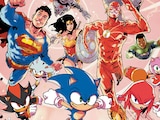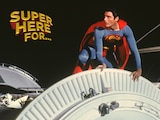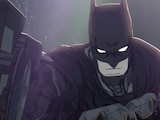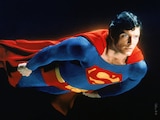At the dawn of the new millennium, Batman producer Michael Uslan and DC Editor Mike Carlin came up with an idea to bring the architect of DC's biggest competition into their fold. That idea became Just Imagine Stan Lee Creating the DC Universe, a twelve-issue event that began in 2001 and saw Lee take on the most famous characters from the DC pantheon. Each issue focused on a different hero, including Batman, Wonder Woman, Superman, Green Lantern, the Flash and ultimately, the Justice League.
Lee's reimagining of DC’s premiere superteam was realized by Superman superstar Jerry Ordway, who is returning to the Just Imagine universe in the new Tales from Earth-6: A Celebration of Stan Lee anthology. In the lead up to the release of the supersized issue, Ordway sat down with DC to reminisce about working with Stan Lee, the joy of writing comics, and how it feels to return to the unique world of Just Imagine after two decades away.

What are some of your standout memories from working on the original Just Imagine?
The main thing I remember from it was a story conference call with Mike Carlin, Michael Uslan, Stan Lee and myself. We just basically threw around ideas for what we would do, one of which was that the Doom Patrol would be the villains in our story because they had a villain name as opposed to a superhero name! And Stan liked the idea of that, so we batted ideas back and forth for probably an hour. At the end of the conversation, Stan said, "I think Jerry's got enough to work on right now, you don't need me to write out a plot." I was like, "I haven't been taking any notes!" Luckily, Mike Carlin chimed in. He had been taking notes and offered to type them up, so we were all good.
Stan didn't like plotting. I think he liked the idea of initiating things, then taking the pages that I drew and adding dialogue. That was his sweet spot. He really enjoyed doing that. He found a voice for each of the characters in that way. But it's a little different than how I think a lot of comics are done now. We're in an age where a lot of scripts have the dialogue and the plot descriptions together so you're dealing with drawing art that has to fit a certain amount of copy in it. Whereas, in that other style, you would basically lay out and pace the whole issue, and write little notes in the margin or the pages or the panels so that the writer—in this case, Stan—could follow whatever you were trying to do and he would play off of that. It was fun!
Stan was exactly what you saw at convention appearances and things like that. He was very optimistic, very positive. It was hard not to be inspired, you know, because he was just so upbeat. He definitely was a tremendous cheerleader for comics.

When you got those dialogue passes back from Stan, was there anything that surprised you? Or any characterizations that changed?
Well, one of the funny things is that in the initial conversation we decided the Doom Patrol would have four members. So, on the splash page, I had done four different distinct characters. And the first thing that came out of (Stan's pass) was seeing the page with a big X over it. He didn't need four guys! He wanted to focus on three characters. To me that's just instinct. You realize that we didn't need the fourth character, which was kind of funny because that was in the plot. But it was always fun and it was never really a surprise because I knew what he was going to deliver based on reading his work over the years.
When I did my very first comic professionally for DC in 1980, I remember getting the pages with lettering on them, you know, hand lettered on the board on the artwork. I was like, "Wow, this is it. I'm actually in comics." And there's a similar kind of feeling when you see, "Oh, Stan Lee just dialogued a story that I worked on." It's like, "Wow, I guess I'm really in comics!"

Stan wasn't the only famed creator behind this massive event, with DC editor Mike Carlin playing a large role in putting it together. Could you talk a little about working with him?
Well, the thing about Mike is he was always a creative editor. There are different types of editors I've worked for over the years, and some of them are, "Here's your thing, go do it." And then you basically would create something and show it to them and the editor would say, "Yeah, I like it," or "I don't." But Mike was always involved in the plotting and he always chimed in and he always had good input. It never felt like he's just trying to write this himself. He was very much about whatever helps or makes the project better. He had a good eye towards overall structure. I think that helped, especially with something like this with twelve issues that have to culminate. They're kind of separate, but then they all had to coalesce with the Crisis storyline at the end of it.
I'd worked with Mike before on Superman and on Shazam as well. In Superman, he was pretty much the ringleader referee, but also a creative partner. I think a lot of people don't understand that based on their understanding of what an editor does. Either they underestimate or they overestimate, but there's kind of that middle ground where you have somebody who hires you and then they let you do what you do best rather than try to remake something into their own vision of it.
One of the most interesting things about this corner of the DC Universe is that you have to recreate these iconic characters without the visual iconography that makes them so recognizable. Was that a challenge?
Well, the basic concepts kind of remain embedded in the Stan Lee versions and we're not talking about a dark dystopian sort of comic book world. They still have a positive vibe. Superman is maybe a little more grumpy in his version, but ultimately he's still a hero. The same is true of Batman and Green Lantern. They're just connected in different ways. I think in a way it's a testament to how—like you mentioned, iconic—there's a certain amount of that built into the best characters. I think that's why they survived for seventy or eighty years. They are capable of being reinterpreted every so often without losing their core values.

Just Imagine always felt like a very unique and singular moment in time, so what does it feel like to return to this universe after two decades?
I think when you read and you love comics, you can basically pull threads from any story. For me, the challenge was to try to get Stan's vibe in it—in the dialogue and in the actual story. I had eight pages, so you can't tell a major story. You have to kind of choose a little slice of life moment or whatever. I think the excitement that happened in the early 2000s, when it was coming out, I knew I was drawing it, but I was in the back seat. It was the Stan show because everybody was coming to see what he would do differently. Ultimately, without that it becomes just another Elseworlds multiple universe kind of story. They’ve even labeled the new special with its own Earth, so it's not hard to slip into it.
In some ways, it's easier because there really hasn't been anything else, so you can kind of imagine what would happen years down the line for this Justice League. But with eight pages, you really are left with just taking little crumbs from the original story. Here that meant Lois Lane was going to represent them, and I just extrapolated that if she's representing them, then maybe that's how they pay for their headquarters. And that's the type of thing Stan did back in the ’60s. He added that element in with the idea of licensing which I don't think a lot of people thought about, but that's there in the early ’60s stuff.

When it came to writing your new story in Tales from Earth-6: A Celebration of Stan Lee, how much fun was it to deliver on the story you set up for Lois all those years ago?
Again, it was easy to do in a sense. I just questioned whether I wanted to make her somehow out and out—she's not evil, but she's kind of obsessed. There's also that little twist that it's not Lois Lane from the Superman we know, it's a separate universe. I tried to set up a little bit of competition between her and Snapper Car too!
When you're doing something like this, you want to make it fun for people to read. You don't want it to just be like you're checking off a list. That's part of doing comics and I guess trying to entertain somebody—you know there are certain things that you as a fan and writer would want to do in a story about a certain character. Then you've got to think, "What am I going to do to maybe change expectations?"
When this new issue comes out, I think a lot of younger readers are probably going to see this world and meet these characters for the first time. What are you most excited for people to discover when they read your story?
Well, they haven't been seen in twenty years outside of the reprint editions, so it'll be a fresh set of characters, basically. Whatever they take away from it, I have no control over that because I really don't know how an audience that isn't familiar with it might react. It's meant as a kind of loving tribute, not necessarily as, "This is exactly the type of comic that's being done today." That wasn't the assignment. So it'll be interesting.

I think people will like it because in a sense, it's a throwback to just the heroic. You know, you try to inject a little realism, but not enough to ruin the concept. Like someone thinking, "Well, what would Batman do? He's a millionaire. He could solve crime with his millions instead of going out and punching out bad guys." I mean, that's an interesting take, but it's almost not relevant to a lot of the original concepts, you know? Those concepts are meant to be simple. That type of thing is very different now, where there are so many layers of subtlety that you can do in a comic that you couldn't do even twenty years ago because we were still under the Comics Code. I think even when you weren't doing a book that was approved by the Comics Code, you still had the guidelines in your head that kind of held you back or kept you from going too far.
This JLA is your little corner of the Just Imagine Earth-6 universe now. Do you have more stories that you'd want to tell in this world and with this team?
Yeah! I mean, whenever you do something like this, you do a lot of research and you get yourself grounded in whatever that little setting is. The sad part about doing a single story for something is that by the end of it you're like, "Wow, I could just keep going and do ten more stories."
You're basically priming the pump, and then the water starts coming up and you have to turn it off!
Tales From Earth-6: A Celebration of Stan Lee #1, featuring Jerry Ordway and a team of talented writers and artists, hits shelves on December 27.




















